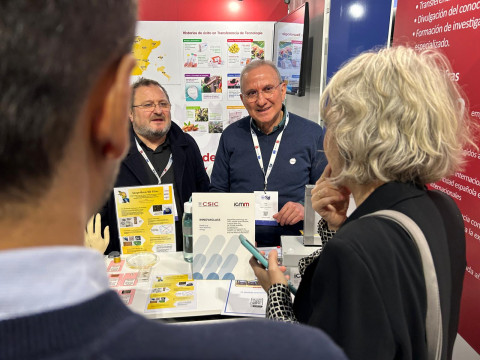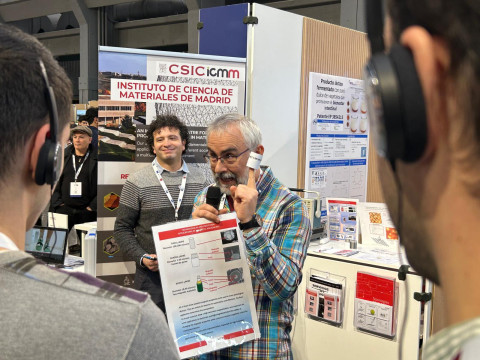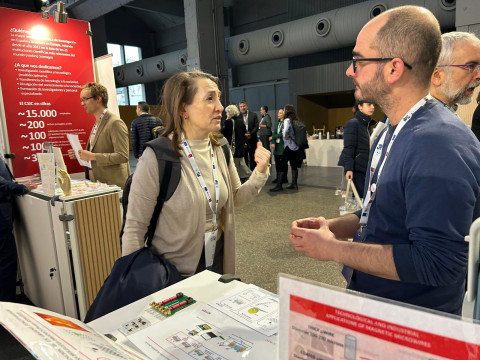The ICMM presents its cutting-edge technologies at Science 4 Industry

Smart windows, magnetic microthreads with technological and industrial applications, chips that diagnose diseases, and ultra-thin two-dimensional material sheets for electronic devices. These are some of the most advanced technologies developed at the Institute of Material Science of Madrid (ICMM-CSIC) and presented this week at the 'Science 4 Industry' event. In addition, two of its spin-offs were also present: Nanostine and Nanological.
"Collaborating with our research teams through R&D and innovation projects helps companies develop their products and technologies, which in turn impacts their business," says José Ángel Martín-Gago, director of the Institute of Material Science of Madrid (ICMM-CSIC) and researcher in one of the technological developments presented.
Solutions for problems. That is the working philosophy of the teams at this research center. "Imagine windows that can adjust their transparency with just one touch," presents David Levy, one of the ICMM-CSIC researchers chosen by the event organizers to showcase his technological development in the so-called 'innovation journeys.' "Most technologies for creating smart windows use electrodes and liquid crystal, which are very expensive," continues the scientist, explaining that this not only makes the production cost of these devices very high but also presents other obstacles related to usage time and energy consumption in their manufacturing. "In fact, that’s why we don’t see these smart windows in buildings," he adds. But he has designed a prototype that solves all these issues.

"With Innovaglass, we make smart windows a plausible option for our homes." How? They have developed a technology that reduces both the cost and the difficulty of manufacturing these devices, which also helps with compliance with sustainability regulations and adds durability due to its resistance to UV rays. "It can be used to control privacy and solar radiation at home, but it is also suitable for flexible, rigid, and curved surfaces," he explains.
Another development selected for the 'innovation journey' was the one presented by Rafael Pérez del Real: technological and industrial applications for magnetic microthreads. "We can design them in such a way that they can serve as magnetic or strain sensors," describes the researcher, who states that this makes them useful in sectors ranging from aerospace to transportation. "We adapt the material to the utility that the company needs."

Another technological development presented by ICMM-CSIC addresses another problem: the manufacturing of two-dimensional material sheets on a large scale. The team led by Andrés Castellanos-Gómez now presents an innovative technique that allows for the cheap and rapid manufacturing of sheets of these materials, with as many uses as one can imagine: "Once we have our film, we perform a thermal processing that allows us to adapt it to different surfaces and uses," explains Esteban Zamora, one of the researchers on the project, showing how these sheets can be incorporated into sensors of all kinds, even inserted into the skin or curved surfaces.
For nanotechnology and biomedicine, a new technique for covalent functionalization of graphene platforms has been presented, with which they have created, for example, biosensors based on graphene transistors. "We prepare them using a physical technique in ultra-high vacuum," explains Jon Azpeitia, a researcher at ICMM-CSIC. "We bombard the graphene sheet and create defects in the graphene; in these gaps, we add molecules and manage to create the graphene-based platform that we use for various applications," adds Irene Palacio, project leader.

In addition to these technological developments, the event also featured two spin-offs born at the Institute: Nanostine and Nanological. The first is dedicated to the research, development, and commercialization of high-value-added nanoparticles and nano-structured coatings. "The nanoparticles manufactured are completely free of ligands on their surface, which makes them especially suitable for applications in different fields, such as aerospace, energy, and nanomedicine," said Yves Huttel and Lidia Martínez, also from ICMM-CSIC.
On the other hand, Nanological is focused on the design of pathogen identification devices. Led by Daniel Ramos, it is made up of a "highly interdisciplinary team of physicists, biologists, data scientists, finance and business development experts, and clinical validation specialists with extensive experience in biosensors." "We believe that only by combining different disciplines can we overcome the limits of current technologies," concludes the scientist.
Instituto de Ciencia de Materiales de Madrid (ICMM)
Sor Juana Ines de la Cruz, 3
Cantoblanco, 28049
Madrid, España
Telephone: (+34) 91 334 90 00
Email: @email
Communication Office: @email

Acknowledge the Severo Ochoa Centres of Excellence program through Grant CEX2024-001445-S/ financiado por MICIU/AEI / 10.13039/501100011033

Contacto | Accesibilidad | Aviso legal | Política de Cookies | Protección de datos